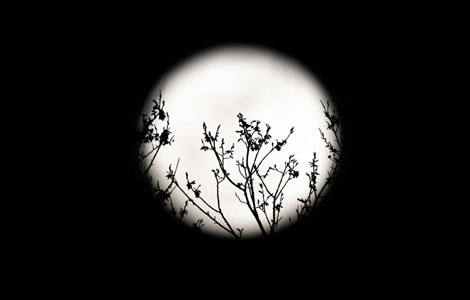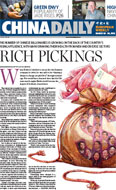Heritage
The history of Chinese imperial food
Updated: 2011-03-10 14:12
(cultural-china.com)
The Grand Secrets of Diets, by Zhu Yizun; the Chance Leisure for Enjoyments, (the part on diets), by Li Yu; and the Menus of the Sui Garden, by Yuan Mei in the Qing Dynasty (1644 - 1911).
Scholars, literati, medical specialists, calligraphers, painters, or historians wrote most of these books. This implies those diets, cooking, and dietotherapy to maintain good health constituted an important part of ancient Chinese culture.
To some extent each nation is closed, and this sense of being closed makes the uniqueness of a nation possible. Being closed often means adopting an attitude of hesitation or refusal toward things foreign, nut a willingness to adopt the strong points of others, especially their foods. Many historians hold that after the Ming Dynasty, China gradually closed its door to the outside, yet many foods from the South and West entered China. Chinese brought them to China not by Westerners and their warships, but on their own initiative.
Some people brought foods into China even at a risk to their own lives. The sweet potato entered China in the middle of the Ming Dynasty. Texts say that Lin Huaizhi, a famous physician in Wuchuan, practiced medicine in Vietnam, where he cured many people. The king of Vietnam gave him sweet potatoes to eat. Because he wanted to bring one back to China, he asked for an uncooked sweet potato. The king gave him one, but Lin only ate two bites and kept the rest. At that time Vietnam prohibited anyone from taking sweet potatoes out of the country. When Lin left, a frontier guard discovered the sweet potato, but because Lin had cured his illness, the officer let him keep the sweet potato as a tribute.
Corn, which originated in America, came to China during the Ming Dynasty, but it was not commonly grown and was regarded as a rare and treasured delicacy. Kaoling or sorghum, which originated in Africa, also entered China during this period.
Soybeans originated in China, but other beans came from abroad. Mung beans (green beans) came from India during the Northern Song Dynasty.
Potatoes, which are eaten both as a staple food and as a vegetable, came from the West. They are believed to have been brought to China by pirates during the Ming Dynasty and were grown in the coastal provinces of Fujian and Zhejiang.
After the Han Dynasty, vegetable oils gradually replaced animal fats as the main heat conducting medium and flavoring agent in cooking. Daily-use vegetable oils came to include sesame, rapeseed, peanut, soybean, and sunflower. Sesame came to China during the Western Han Dynasty and soybeans were native to China, but the other oil-bearing crops did not enter China until after the Southern and Northern Dynasties.
Sugar, China’s most important sweetener, first appeared during the Tang Dynasty (617 -907). During the Warring States Period (475 – 221 B.C.), people in the State of Chu had learned to extract the sweet flavoring from sugar cane juice. Emperor Taizong of the Tang Dynasty sent an envoy to the Western Region to learn how to make sugar. After the envoy returned home, he used sugar cane from Yangzhou to make sugar. Its color and flavor were superior to that produced in the Western Region, so granulated sugar came to play a key role in Chinese cooking.
Because sugar is water-soluble, it became an important flavoring used to make food sweet and delicious. It is used in soup and in cooking all kinds of dishes. Malt sugar and honey, which were used as sweeteners and flavorings before the Han Dynasty, now are used mostly to make thick soup.
Hot peppers are eaten widely in China. People in Hunan, Hubei and Sichuan are addicted to eating them and call them “meat for the poor” or salt, meaning they go well with rice like meat or salt. Hot peppers stimulate the appetite and dispel internal cold. They originated in South America, and were brought into China from Southeast Asia about the 15th century during the final years of the Ming Dynasty or the early years of the Qing Dynasty.
One of the first vegetables brought into China was spinach. At first it was called the Persian vegetable because it came to China from Persia (present – day Iran) when Emperor Taizong of the Tang Dynasty was in power. Because it has red roots, it was also called the red – root vegetable. As spinach is tender, it cannot be cooked very long. It grows in all seasons in areas south of the Yangtze River, so it is considered an ordinary vegetable.
A popular, nutritious vegetable grown in North China that originated elsewhere is the carrot, which came from Europe. It is used in cooking or eaten raw. People along the northern bank of the Yangtze River in Jiangsu Province developed the habit of eating it raw at noontime.
Eggplant originated in India and was brought into China along with Buddhism during the Southern and Northern Dynasties. It grows as tall as two meters (almost 80 inches), in southern China, but in northern China it is considered an annual herb.
Some other vegetables are native to China, but they were not well known in ancient times. They became recognized only after the Han Dynasty. Among these is song, known today as Chinese cabbage, which became known as an autumn vegetable in the Southern and Northern Dynasties. Song was an important winter vegetable for all of northern China.
Water shield became important after Zhang Han, a high-ranking official of the Western Jin Dynasty (265-316), became homesick for the vegetables and other native delicacies. Bamboo shoots, mushrooms, wax gourds (winter melons), and vegetable beans also became common after the Song Dynasty. These vegetables, plus chives, radishes, onions, cucumbers, three-colored amaranths, and turnips were the principal vegetables during this period. Cabbage, tomato, and cauliflower were only introduced into China several decades ago.
People in the Qing Dynasty treasured shark’s fin and edible bird’s nest, which are indispensable ingredients at modern, opulent banquets. These two foods were brought into China from Southeast Asia in the early years of the Ming Dynasty when the eunuch, Zheng He, returned from there. During the middle period of the Qing Dynasty, edible bird’s nest and shark’s fin headed the menus at extravagant banquets. Sea cucumbers and prawns are native to China, but only became imperial dishes much later.
As cities and towns began to develop and thrive, cooking became a commercial activity and many restaurants were opened. Some cooks freed themselves from their slave status of serving the royal family and nobility by becoming independent laborers who sold their cooking skills. Many famous cooks and chefs emerged, among them Song Wusao in the Southern Song Dynasty and Wang Eryu in the Qing Dynasty.
Scholars also became interested and involved in cooking during this period by recording the cooks’ knowledge, creativity, processes, and recipes for later generations. Using their education and aesthetic ability, they urged the cooks to make dishes more appealing to the senses of sight, smell, taste and touch. They were gourmets who knew diets and cooking very well, and they helped the cooks create a dietetic culture. They were connoisseurs and critics, propellers of progress, and recorders of the cooking experience.
Because of cultural exchanges between China and other countries, foods not native to China, such as corn sweet potatoes, peanuts, and hot peppers, gradually entered the daily lives of the Chinese people. Many regions developed cuisines with unique flavors as a result of these exchanges.
To some extent peoples’ food and drink are influenced by regional divisions, but the primary influences are peoples’ income, education, culture, and religious beliefs. For these reasons, China developed several dietetic cultures. These include the imperial, aristocratic, literati, market, and temple cuisines. Especially during the Ming and Qing Dynasties, imperial food and drink were closely tied to preserving health, which led to the development of unique imperial food.
E-paper

City of Joy
Welcome to the 'world of smiles' where life meanders slowly.
Debate on nuclear power revived
The future is now
Common approach
Specials

Beloved polar bear died
Berlin's beloved polar bear Knut, an international star died Saturday.

Panic buying of salt
Worried Chinese shoppers stripped stores of salt on radiation fears.

'Super moon'
The "Super Moon" arrives at its closest point to the Earth in 2011.
